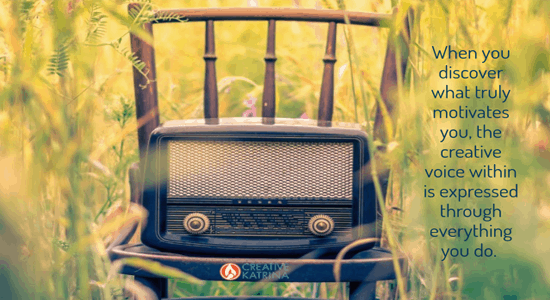
“Creative Katrina” Pfannkuch is a Creative specialist with incredible tips and methods to tap into and hone our creative side of our brains. This week, we learn Katrina’s thoughts on “Mindset” as we discuss her contributions to my book “Entrepreneur Mind Hacks”, including her chapter titled “Four Ways to Sharpen Your Creative Edge”.
As Katrina puts it, we are all too familiar with the word “rut”. This isn’t always a bad thing, in fact it often comes out of doing something very well… so well, that we simply keep doing it in the way that we’ve always done it… putting us into a rut. Sometimes, becoming quite good at something is actually bad for us because we don’t always put out our best effort, as it becomes almost natural to do things as we always have.
However, in order to take things to the next level, you need to break out of your rut and creatively find ways to make that happen.
So, by “creative edge”, Katrina is encouraging us to have the courage to take a step further than we have gone before – outside of our comfort zones – in order to grow.
The first method Katrina prescribes is to challenge yourself with something new, rather than expanding the reach of a current goal. Too often, when something isn’t going or growing as we had hoped, we are quick to judge ourselves and our efforts, instead of seeing the opportunities and possibilities that stand before us. But, when we start something completely new, we tend to go into it with a more open heart and mind – without expectations – because we can look at it with a healthy perspective.
But, let’s say there doesn’t seem to be time – with an impeding deadline looming – to “start something new”. What then? Katrina recommends shifting gears in your project – take 20 minutes or so to take a stab at a different aspect of the project than you’ve been grinding at and approach that aspect with a new, creative perspective. This will likely rekindle your energy not only in that aspect, but also the section of the project where you are stuck in a rut.
And, it feels good to be reminded what is possible in your endeavors!
According to Katrina, emotions – how you feel – play a key role in overcoming creative blocks AND what she calls “stepping into your true voice”. We tend to spend all our working days in our mind with to-do lists, projects, deadlines, etc. But we rarely allow ourselves to feel anything about these projects and to-do items. This disconnection between what we are doing, what we think about it and how we feel about it causes frustration.
In reality, creativity is very much a “body sensation”, which involves our feelings. So, if we are connected to what our heart’s passion is, we will be much more aware of what it feels like when we are working along the right path for us.
But, what about those of us who are more “systems-oriented”? What does “stepping into your true voice” mean to us?
Well, as Katrina puts it, even the most “systematic” of people are very creative. They are tasked with the goal of taking their systems and developing them in such a way that supports other people’s needs… many of which need to be anticipated and forecasted. This, alone, is a very creative act.
All this to say, “your true voice” is how you express yourself when it is completely aligned with who you are.
Katrina also says that we need to acknowledge and honor your inner voice above all others. As with any entrepreneurial space, we are looking at what other people are doing. There are a lot of ways to look outside of our own bubble – What are our competitors doing? What are the experts recommending? But, if you are not clear on what your passion is, from the beginning, you won’t be able to pick out the right people to follow when attempting to look outside. So, while these experts and competitors may seem very clear in their methods, they may not be the right methods for you, and following their example could actually backfire on you.
Everyone learns by doing. There are no exceptions. This can be scary when you are attempting something new, or even something familiar, but with a new perspective. This boils down to the fear of the unknown – How will this work? How well will I succeed or will I fail? How will this affect others?
And the first step is often the most difficult, because there is rarely a structure to follow. However, until you start doing it a new way (or doing a new thing), you will never learn how well it will work. You must do it to learn it. When you hypothesize in your mind, you can come up with a lot of unreal scenarios that could play out, which might discourage you from even trying. By doing it, you actually have hard evidence of what is working and what isn’t, based on evidentiary fact. By doing, you can learn to shift directions on the fly, which is a huge part of creativity.
One aspect to maximizing your creative strength that is often ignored, is discovering which part of the day is your “groove time”? Are you more creatively energized in the early morning? Afternoon? Evening?
Katrina also insists that each of us must believe in what we create – both during and after the creation process. When we are unsure how people will receive what we are creating, we find ourselves emotionally and practically going out on a limb. Therefore, it’s very important to ease up on ourselves when it comes to our own expectations. This will help alleviate internal frustration that would otherwise bubble up when our expectations of how other people will react aren’t met. And, it’s no surprise that if you are frustrated during the creation process, then your creation will not be as full and complete as if you were less bound by these unfound expectations.
Now, after you have created something – say, an online course or other entrepreneurial effort – but before you release it, there should be an assessment process where you can fine-tune what you have done and improve it. This can easily be accomplished with a creative mindset by stepping away from it for a day or two, and then approaching it with a fresh mind, attitude and perspective. When you refine your work, look at it from the perspective of your potential client or buyer, not from you, the creator. Think like they would. But, don’t be judgmental, be practical.
In fact, you don’t even have to wait until your creative process is completed to practically assess your work. You can have these practical moments before you begin and mid-process in order to avoid spinning your wheels in a direction that isn’t practical.
It all boils down to your intention.
When you are either self-assessing, or offering your work to trusted people for their input, are your intentions to hone and refine your creation, or are you aiming to chase the illusive target of making everyone else happy? Not to say that you must remain stalwart and never adjust the path that you are on, but do so with the right creative intentions.
To do this correctly takes both humility and courage. It’s not easy to dig into the depths of your passions and offer it for other people to review. But, afterward, you will have better insights from people you trust. This is good to have cleared out before you are bombarded by clients who may not understand your actual intentions.
Katrina also wrote a chapter in my book titled: Three Simple Tips for Listening to Your Creative Gut. As she puts it, your creative gut is the really fun part of self-discovery. You see, if you never take time away from the routines and tasks that you HAVE to do each day, you end up drowning out that natural, creative voice inside you that yearns to inspire you with great ideas. Our creative gut is that voice that wants to be heard, telling us:
“Here is the seed of a good idea… I’d like to see, if planted, how can it grow?”
But, if we are always busy and never allow ourselves time to get out of our rut (through walking, meditating, changing the scene around ourselves, etc.) then we can never have the time or ability to even be aware of our creative gut.
There are a few questions that Katrina poses that might help you hear that voice more clearly:
Do you feel one thing in your heart, but hear another voice in your mind telling you something different?
Katrina reminds us that we aren’t just a mind. Nor are we just a body. Nor are we just a spirit. We are a culmination of all three of these. These three things may send conflicting messages, though. This is part of the fun of the creative process, according to Katrina. This is the puzzle-solving of honestly and carefully looking at each of these messages and discerning their legitimacy and relevance.
Is there and intriguing idea that cycles back over and over, but you ignore it?
Many of us have this happen to us. These ideas and their corresponding reminders subtly collect, yet go unnoticed. If we acknowledge them and look at them more carefully, though, they may end up being very helpful guiding factors in our lives and careers. They often point to what you are tuned into, where your heart is leading, or opportunities that lie outside of your current rut. Now, it’s extremely easy to come up with reasons why you couldn’t or shouldn’t do something… and these clues and assessments might actually be quite practical in your process. However, this “internal pessimism” might also dominate you and put an end to your creativity.
When these “naysayers” pop into your mind, Katrina advises this: ask yourself if you are afraid because “X,Y, or Z” is going to happen? Or are you afraid to actually “step into your greatness”?
These two things can feel very similar, but they come from very different place and have very different results. We tend to go through our careers, discovering one or two things that we are good at, and resigning ourselves that THAT is our niche. This mindset may be prohibiting us from finding what other things we might be great at. Therefore, we need to stop limiting ourselves in what we think we are capable of.
This boils down to Katrina’s sage advice: Be careful not to judge yourself into a corner. Healthily assessing yourself is one thing, but judging yourself into inaction is neither healthy nor productive. Too often, we find ourselves playing a game of chess against ourselves – we think of a move, and then a counter move for each side of the board, to the point where we don’t move forward at all. By doing this, we quench our creative voice altogether, for this instance and possibly for future endeavors as well.
You can learn more from Katrina at CreativeKatrina.com.